Climate Warming-Driven Expansion and Retreat of Alpine Scree in the Third Pole over the Past 45 Years
Abstract
1. Introduction
2. Materials and Methods
2.1. Study Areas
2.2. Method of Mapping Alpine Scree
2.3. Determination of Critical Threshold of Slope (θ)
2.4. Field Investigation and Verification
2.5. Statistical Analysis
3. Results
3.1. Ground-Truth Verification of Alpine Scree
3.2. Spatial Distribution and Characteristics of Alpine Scree
3.3. Trends in Alpine Scree Changes
3.4. Impact of Climate Change on Alpine Scree
4. Discussion
5. Conclusions
Supplementary Materials
Author Contributions
Funding
Data Availability Statement
Acknowledgments
Conflicts of Interest
References
- Yang, P.; Shu, X.; Chen, J.; Ni, M.; Wang, X.; Ti, B.; Jiang, C. Investigation on Plant Resources of Alpine Screes in Baimaxueshan National Nature Reserve. For. Surv. Plan. 2021, 46, 140–143. [Google Scholar]
- Gaur, U.N.; Raturi, G.P.; Bhatt, A.B. Quantitative response of vegetation in glacial moraine of central Himalaya. Environmentalist 2003, 23, 237–247. [Google Scholar] [CrossRef]
- Grabherr, G.; Gottfried, M.; Pauli, H. Climate Change Impacts in Alpine Environments. Geogr. Compass 2010, 4, 1133–1153. [Google Scholar] [CrossRef]
- Chen, X.; Zhao, L.; Hu, X.; Liu, M.; Luo, C.; Jiang, S.; Gu, X.; Guan, T. The seasonal activity patterns of bharal (Pseudois nayaur) in forest-meadow mosaic habitat. Chin. J. Zool. 2020, 55, 692–701. [Google Scholar]
- Vanneste, T.; Michelsen, O.; Graae, B.J.; Kyrkjeeide, M.O.; Holien, H.; Hassel, K.; Lindmo, S.; Kapás, R.E.; De Frenne, P. Impact of climate change on alpine vegetation of mountain summits in Norway. Ecol. Res. 2017, 32, 579–593. [Google Scholar] [CrossRef]
- Wang, G.; Bai, W.; Li, N.; Hu, H. Climate changes and its impact on tundra ecosystem in Qinghai-Tibet Plateau, China. Clim. Change 2010, 106, 463–482. [Google Scholar] [CrossRef]
- Choler, P.; Bayle, A.; Fort, N.; Gascoin, S. Waning snowfields have transformed into hotspots of greening within the alpine zone. Nat. Clim. Change 2024, 15, 80–85. [Google Scholar] [CrossRef]
- Xie, Y.; Balazs, A.; Gerya, T.; Xiong, X. Uplift of the Tibetan Plateau driven by mantle delamination from the overriding plate. Nat. Geosci. 2024, 17, 683–688. [Google Scholar] [CrossRef]
- Willett, S.D. How do mountains grow? Nat. Rev. Earth Environ. 2025, 6, 6. [Google Scholar] [CrossRef]
- Li, G.K.; Moon, S. Topographic stress control on bedrock landslide size. Nat. Geosci. 2021, 14, 307–313. [Google Scholar] [CrossRef]
- Braun, J.; Simon-Labric, T.; Murray, K.E.; Reiners, P.W. Topographic relief driven by variations in surface rock density. Nat. Geosci. 2014, 7, 534–540. [Google Scholar] [CrossRef]
- Egholm, D.L.; Nielsen, S.B.; Pedersen, V.K.; Lesemann, J.E. Glacial effects limiting mountain height. Nature 2009, 460, 884–887. [Google Scholar] [CrossRef]
- Hou, Z.; Liu, L.; Zhang, H.; Xu, B.; Wang, Q.; Yang, T.; Wang, R.; Zheng, Y.; Li, Y.; Gao, L.; et al. Cenozoic eastward growth of the Tibetan Plateau controlled by tearing of the Indian slab. Nat. Geosci. 2024, 17, 255–263. [Google Scholar] [CrossRef]
- Cui, L.; Yang, Y.; Xu, S.; Zhao, Z.; Mao, H.; Zhang, X.; Tu, C.; Zhang, Z.; Liu, W.; Liu, C. Denudation rates of granitic regolith along climatic gradient in Eastern China. Geomorphology 2021, 390, 107872. [Google Scholar] [CrossRef]
- Hao, D.; Bisht, G.; Gu, Y.; Leung, L.R. Regional and Teleconnected Impacts of Solar Radiation-Topography Interaction over the Tibetan Plateau. Geophys. Res. Lett. 2023, 50, e2023GL106293. [Google Scholar] [CrossRef]
- Zhang, Y.; Li, H. Late Cenozoic tectonic events in east Tibetan Plateau and extrusion-related orogenic system. Geology China 2016, 43, 1829–1852. [Google Scholar] [CrossRef]
- Xu, L.; Herold, M.; Tsendbazar, N.-E.; Masiliūnas, D.; Li, L.; Lesiv, M.; Fritz, S.; Verbesselt, J. Time series analysis for global land cover change monitoring: A comparison across sensors. Remote Sens. Environ. 2022, 271, 112905. [Google Scholar] [CrossRef]
- Liu, X.; Huang, Y.; Xu, X.; Li, X.; Li, X.; Ciais, P.; Lin, P.; Gong, K.; Ziegler, A.D.; Chen, A.; et al. High-spatiotemporal-resolution mapping of global urban change from 1985 to 2015. Nat. Sustain. 2020, 3, 564–570. [Google Scholar] [CrossRef]
- Hurtt, G.C.; Chini, L.; Sahajpal, R.; Frolking, S.; Bodirsky, B.L.; Calvin, K.; Doelman, J.C.; Fisk, J.; Fujimori, S.; Klein Goldewijk, K.; et al. Harmonization of global land use change and management for the period 850–2100 (LUH2) for CMIP6. Geosci. Model Dev. 2020, 13, 5425–5464. [Google Scholar] [CrossRef]
- Winkler, K.; Fuchs, R.; Rounsevell, M.; Herold, M. Global land use changes are four times greater than previously estimated. Nat. Commun. 2021, 12, 2501. [Google Scholar] [CrossRef]
- Song, X.-P.; Hansen, M.C.; Stehman, S.V.; Potapov, P.V.; Tyukavina, A.; Vermote, E.F.; Townshend, J.R. Global land change from 1982 to 2016. Nature 2018, 560, 639–643. [Google Scholar] [CrossRef]
- Zhang, Y.; Liu, L.; Wang, Z.; Bai, W.; Ding, M.; Wang, X.; Yan, J.; Xu, E.; Wu, X.; Zhang, B.; et al. Spatial and temporal characteristics of land use and cover changes in the Tibetan Plateau. Chin. Sci. Bull. 2019, 64, 2865–2875. [Google Scholar] [CrossRef]
- Wang, Z.; Li, Z.; Dong, S.; Fu, M.; Li, Y.; Li, S.; Wu, S.; Ma, C.; Ma, T.; Cao, Y. Evolution of ecological patterns and its driving factors on Qinghai-Tibet Plateau over the past 40 years. Acta Ecol. Sinica 2022, 42, 8941–8952. [Google Scholar]
- Wang, X. Distribution Map of Desert Ecosystem Types on the Tibetan Plateau; SinoMaps Press: Beijing, China, 2021. [Google Scholar]
- Wang, X.; Geng, X.; Liu, B.; Cai, D.; Li, D.; Xiao, F.; Zhu, B.; Hua, T.; Lu, R.; Liu, F. Desert ecosystems in China: Past, present, and future. Earth Sci. Rev. 2022, 234, 104206. [Google Scholar] [CrossRef]
- Yao, C.; Liu, X.; Wang, N. The magnitude of climate change in the Tibetan Plateau. Chin. Sci. Bull. 2000, 45, 98. [Google Scholar] [CrossRef]
- Yao, T.; Bolch, T.; Chen, D.; Gao, J.; Immerzeel, W.; Piao, S.; Su, F.; Thompson, L.; Wada, Y.; Wang, L.; et al. The imbalance of the Asian water tower. Nat. Rev. Earth Environ. 2022, 3, 618–632. [Google Scholar] [CrossRef]
- You, Q.; Cai, Z.; Pepin, N.; Chen, D.; Ahrens, B.; Jiang, Z.; Wu, F.; Kang, S.; Zhang, R.; Wu, T.; et al. Warming amplification over the Arctic Pole and Third Pole: Trends, mechanisms and consequences. Earth Sci. Rev. 2021, 217, 103625. [Google Scholar] [CrossRef]
- You, Q.; Chen, D.; Wu, F.; Pepin, N.; Cai, Z.; Ahrens, B.; Jiang, Z.; Wu, Z.; Kang, S.; AghaKouchak, A. Elevation dependent warming over the Tibetan Plateau: Patterns, mechanisms and perspectives. Earth Sci. Rev. 2020, 210, 103349. [Google Scholar] [CrossRef]
- Hugonnet, R.; McNabb, R.; Berthier, E.; Menounos, B.; Nuth, C.; Girod, L.; Farinotti, D.; Huss, M.; Dussaillant, I.; Brun, F.; et al. Accelerated global glacier mass loss in the early twenty-first century. Nature 2021, 592, 726–731. [Google Scholar] [CrossRef]
- Shean, D.E.; Bhushan, S.; Montesano, P.; Rounce, D.R.; Arendt, A.; Osmanoglu, B. A systematic, regional assessment of high mountain Asia glacier mass balance. Front. Earth Sci. 2020, 7, 363. [Google Scholar] [CrossRef]
- Kraaijenbrink, P.D.A.; Bierkens, M.F.P.; Lutz, A.F.; Immerzeel, W.W. Impact of a global temperature rise of 1.5 degrees Celsius on Asia’s glaciers. Nature 2017, 549, 257–260. [Google Scholar] [CrossRef]
- Ouyang, Z.; Zhang, G.; Ying, L. Overview of the impacts of climate change on ecosystem distribution and functions across the Tibetan Plateau. Adv. Clim. Change Res. 2024, 20, 699–710. [Google Scholar] [CrossRef]
- Corlett, R.T.; Westcott, D.A. Will plant movements keep up with climate change? Trends Ecol. Evol. 2013, 28, 482–488. [Google Scholar] [CrossRef]
- Higgins, S.I.; Nathan, R.; Cain, M.L. Are long-distance dispersal events in plants usually caused by nonstandard means of dispersal? Ecology 2003, 84, 1945–1956. [Google Scholar] [CrossRef]
- Awang; Zhang, L.; Sun, J.; Zhang, S.; Xia, L.; Wang, S. Research advance on the key factors affecting the migration of alpine grassland plants to high altitude or high latitude in Qinghai-Tibet Plateau. Chin. J. Ecol. 2021, 40, 1521–1529. [Google Scholar]
- Ying, L.; Wang, L.; Huang, X.; Rao, E.; Xiao, Y.; Zheng, H.; Shen, Z.; Ouyang, Z. Climate change impairs the effects of vegetation improvement on soil erosion control in the Qinghai-Tibetan Plateau. Catena 2024, 241, 108062. [Google Scholar] [CrossRef]
- Yan, L.Y.; Kong, L.Q.; Ouyang, Z.Y.; Hu, J.M.; Zhang, L. Survival Risk Analysis for Four Endemic Ungulates on Grasslands of the Tibetan Plateau Based on the Grazing Pressure Index. Remote Sens. 2024, 16, 4589. [Google Scholar] [CrossRef]
- Qi, L.; Wang, J.; Zhang, D.; Zhang, Y.; Ma, J. Evaluation of the influence of freeze-thaw cycles on the joint strength of granite in the Eastern Tibetan Plateau, China. Sci. Rep. 2024, 14, 24085. [Google Scholar] [CrossRef]
- Xiao, Z.; Song, M.; Zhou, J.; Shi, L.; Yang, Y. Spatial heterogeneity of microbial community and functional groups of different cushion species in alpine scree habitat in northwestern Yunnan, China. Chin. J. Appl. Environ. Biol. 2021, 27, 1119–1129. [Google Scholar] [CrossRef]
- Maurer, J.M.; Schaefer, J.M.; Rupper, S.; Corley, A. Acceleration of ice loss across the Himalayas over the past 40 years. Sci. Adv. 2019, 5, eaav7266. [Google Scholar] [CrossRef]
- Wu, B. Medium Resolution Land Cover Data of Qinghai-Tibet Plateau (1980–2020). 2023. Available online: https://data.tpdc.ac.cn/en/data/ca5ea591-83d1-4251-815b-caf6c9e4012b (accessed on 13 July 2023).
- Kamberaj, H. Classical Mechanics; De Gruyter: Berlin, Germany, 2021. [Google Scholar]
- Erbani, J.; Portier, P.-É.; Egyed-Zsigmond, E.; Nurbakova, D. Confusion Matrices: A Unified Theory. IEEE Access 2024, 12, 181372–181419. [Google Scholar] [CrossRef]
- Zielinski, W.; Węglarczyk, S.; Kuchar, L.; Michalski, A.; Kazmierczak, B. Kernel density estimation and its application. ITM Web Confer. 2018, 23, 00037. [Google Scholar] [CrossRef]
- Zheng, D.; Zhang, G.; Shan, H.; Tu, Q.; Wu, H.; Li, S. Spatio-Temporal Evolution of Urban Morphology in the Yangtze River Middle Reaches Megalopolis, China. Sustainability 2020, 12, 1738. [Google Scholar] [CrossRef]
- Dey, D.; Haque, M.S.; Islam, M.M.; Aishi, U.I.; Shammy, S.S.; Mayen, M.S.A.; Noor, S.T.A.; Uddin, M.J. The proper application of logistic regression model in complex survey data: A systematic review. BMC Med. Res. Methodol. 2025, 25, 15. [Google Scholar] [CrossRef]
- Peng, S. 1-km Monthly Mean Temperature Dataset for China (1901–2023). 2024. Available online: https://data.tpdc.ac.cn/en/data/71ab4677-b66c-4fd1-a004-b2a541c4d5bf/ (accessed on 15 August 2023).
- Peng, S. 1-km Monthly Precipitation Dataset for China (1901–2023). 2024. Available online: https://zenodo.org/records/3114194 (accessed on 22 May 2019).
- Peng, S. 1-km Annual Arid Index Dataset for China (1901–2023). 2024. Available online: https://data.tpdc.ac.cn/en/data/b7a5c363-3f63-4921-b657-8a4229476ec1 (accessed on 15 August 2023).
- Zheng, M.; Zhou, Z. Seed Plant Diversity on Screes from Northwest Yunnan. Acta Bot. Yunnan 2004, 26, 23–32. [Google Scholar]
- Xing, Y. The “Plant Star” on the alpine scree of Yulong Snow Mountain. Popular Sci. 2021, Z2, 43–45. [Google Scholar]
- Qin, J.; Yang, B.; Ding, Y.; Cui, J.; Zhang, Y. Assessment of runoff generation capacity and total runoff contribution for different landscapes in alpine and permafrost watershed. Catena 2025, 249, 108643. [Google Scholar] [CrossRef]
- Huber, C.J.; Eichler, A.; Mattea, E.; Brutsch, S.; Jenk, T.M.; Gabrieli, J.; Barbante, C.; Schwikowski, M. High-altitude glacier archives lost due to climate change-related melting. Nat. Geosci. 2024, 17, 110–113. [Google Scholar] [CrossRef]
- Liu, J.; Wu, Y.; Gao, X. Increase in occurrence of large glacier-related landslides in the high mountains of Asia. Sci. Rep. 2021, 11, 1635. [Google Scholar] [CrossRef]
- Chen, D.; Xu, B.; Yao, C.; Guo, Z.; Cui, P.; Chen, F.; Zhang, R.; Zhang, X.; Zhang, Y.; Fan, J.; et al. Assessment of past, present and future environmental changes on the Tibetan Plateau. Chin. Sci. Bull. 2015, 60, 3025–3035. [Google Scholar] [CrossRef]
- Wei, Y.; Lu, H.; Wang, J.; Wang, X.; Sun, J. Dual Influence of Climate Change and Anthropogenic Activities on the Spatiotemporal Vegetation Dynamics over the Qinghai-Tibetan Plateau from 1981 to 2015. Earth’s Future 2022, 10, e2021EF002566. [Google Scholar] [CrossRef]
- Chen, F.; Wang, Y.; Zhen, X.; Sun, J. Research on the environmental impact and response strategies of the Tibetan Plateau under global change. China Tibet. 2021, 21–28. Available online: http://www.tibetology.ac.cn/2022-02/25/content_41888120.htm (accessed on 15 July 2025).
- Wang, X.; Yue, J.; Sun, H.; Li, Z. Phylogeographical Study on Eriophyton wallichii (Labiatae) from Alpine Scree of Qinghai-Tibetan Plateau. Plant Divers. Resour. 2011, 33, 605–614. [Google Scholar]
- Zhang, Y.; Zhao, R.; Liu, Y.; Huang, K.; Zhu, J. Sustainable wildlife protection on the Qingzang Plateau. Geogr. Sustain. 2021, 2, 40–47. [Google Scholar] [CrossRef]
- He, X.; He, K.S.; Hyvönen, J. Will bryophytes survive in a warming world? Perspect. Plant Ecol. 2016, 19, 49–60. [Google Scholar] [CrossRef]
- He, X. Landscape Pattern Analysis and Ecological Risk Assessment of the Qinghai Tibet Plateau Basin: A Case Sudy of the Niyang Rver Basin; University of Chinese Academy of Sciences: Beijing, China, 2005. [Google Scholar]
- Wang, X.; Liang, W.; Wan, D.; Yu, W.; Yang, H. Spatial variation characteristics and influencing factors of soil organic carbon in a rocky beach of Sejila Mountain, Tibetan Plateau. Bull. Soil Water Conserv. 2023, 43, 359–366. [Google Scholar]
- Wang, L.; Liu, H.; Bhlon, R.; Chen, D.; Long, J.; Sherpa, T.C. Modeling glacio-hydrological processes in the Himalayas: A review and future perspectives. Geogr. Sustain. 2024, 5, 179–192. [Google Scholar] [CrossRef]
- Meng, X. Study on the influencing factors of friction coefficient on ice and snow road surface. Highw. Transp. Inn. Mong. 2014, 1, 60–61. Available online: https://www.docin.com/p-1397513867.html (accessed on 15 July 2025).
- Schumann, K.; Gewolf, S.; Tackenberg, O. Factors affecting primary succession of glacier foreland vegetation in the European Alps. Alp. Bot. 2016, 126, 105–117. [Google Scholar] [CrossRef]
- Li, R.; Han, G.; Sun, J.; Zhou, T.; Chen, J.; He, W.; Wang, Y. Dynamics and controls of ecosystem multiserviceability across the Qingzang Plateau. Geogr. Sustain. 2023, 4, 318–328. [Google Scholar] [CrossRef]
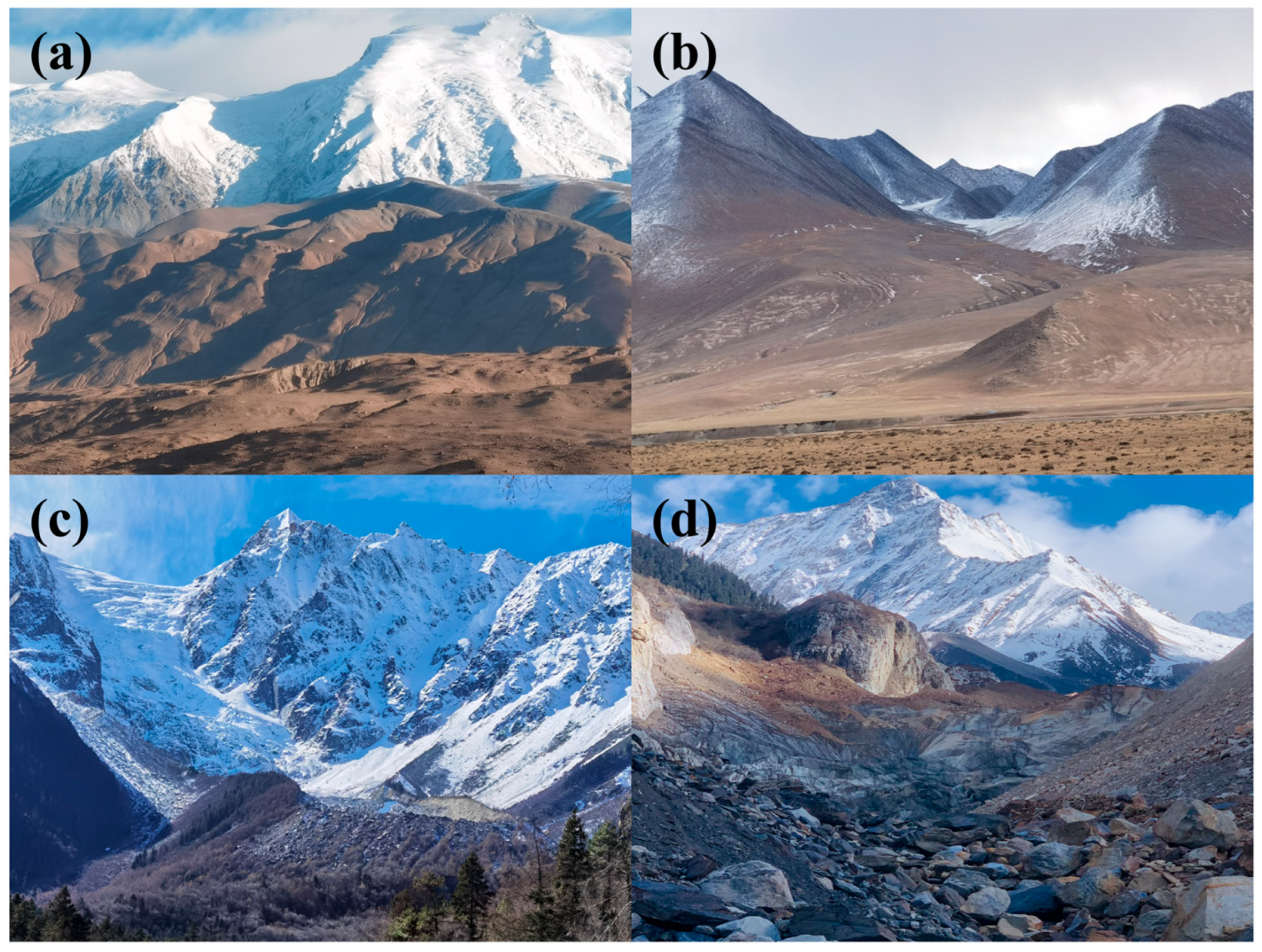
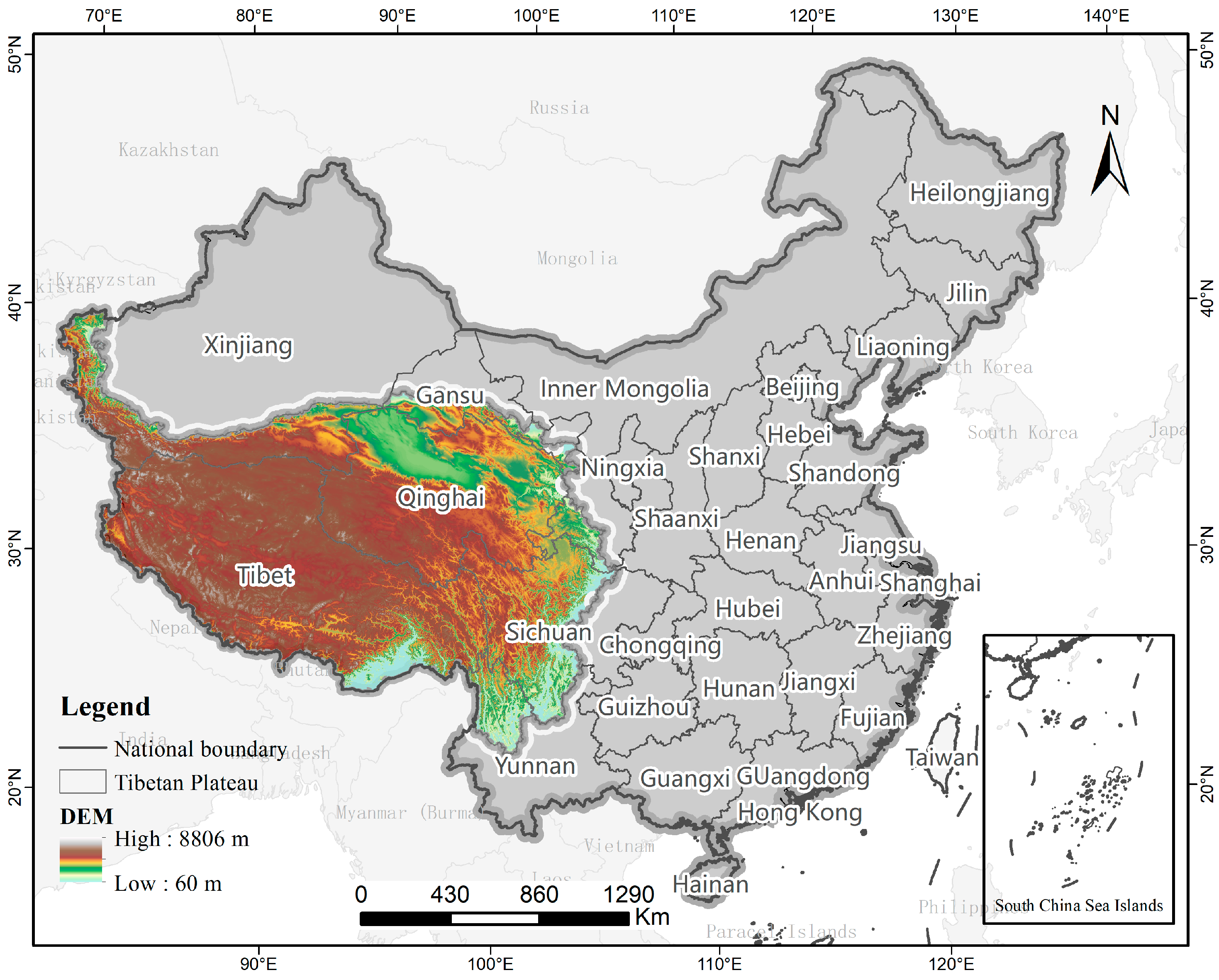
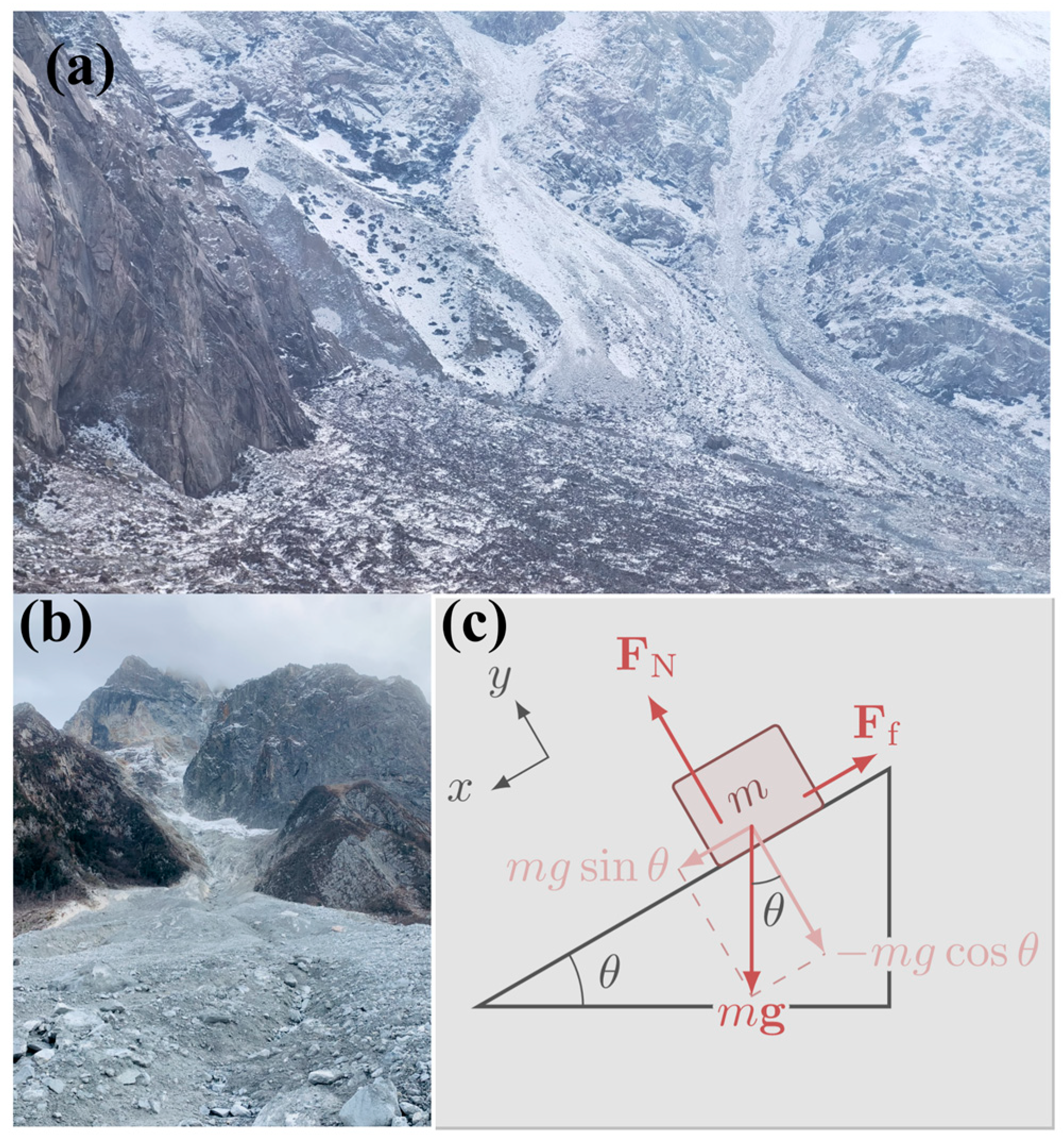
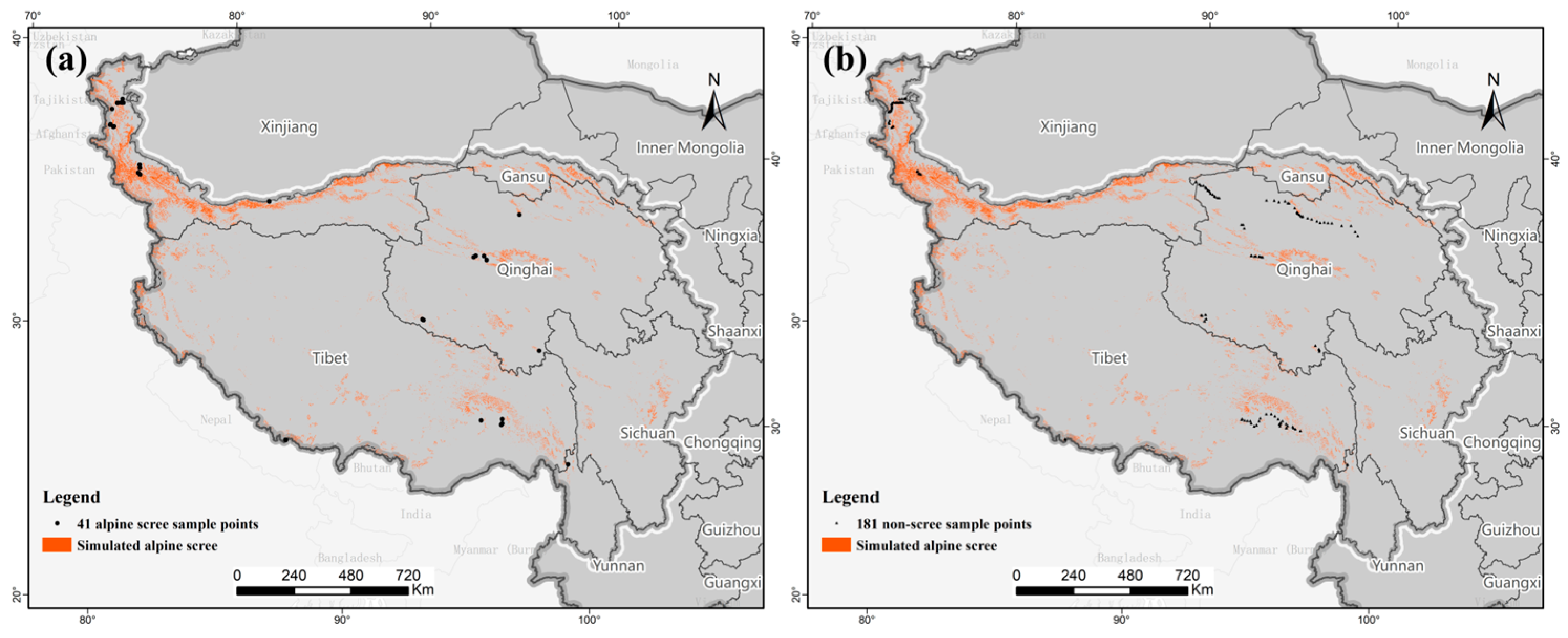
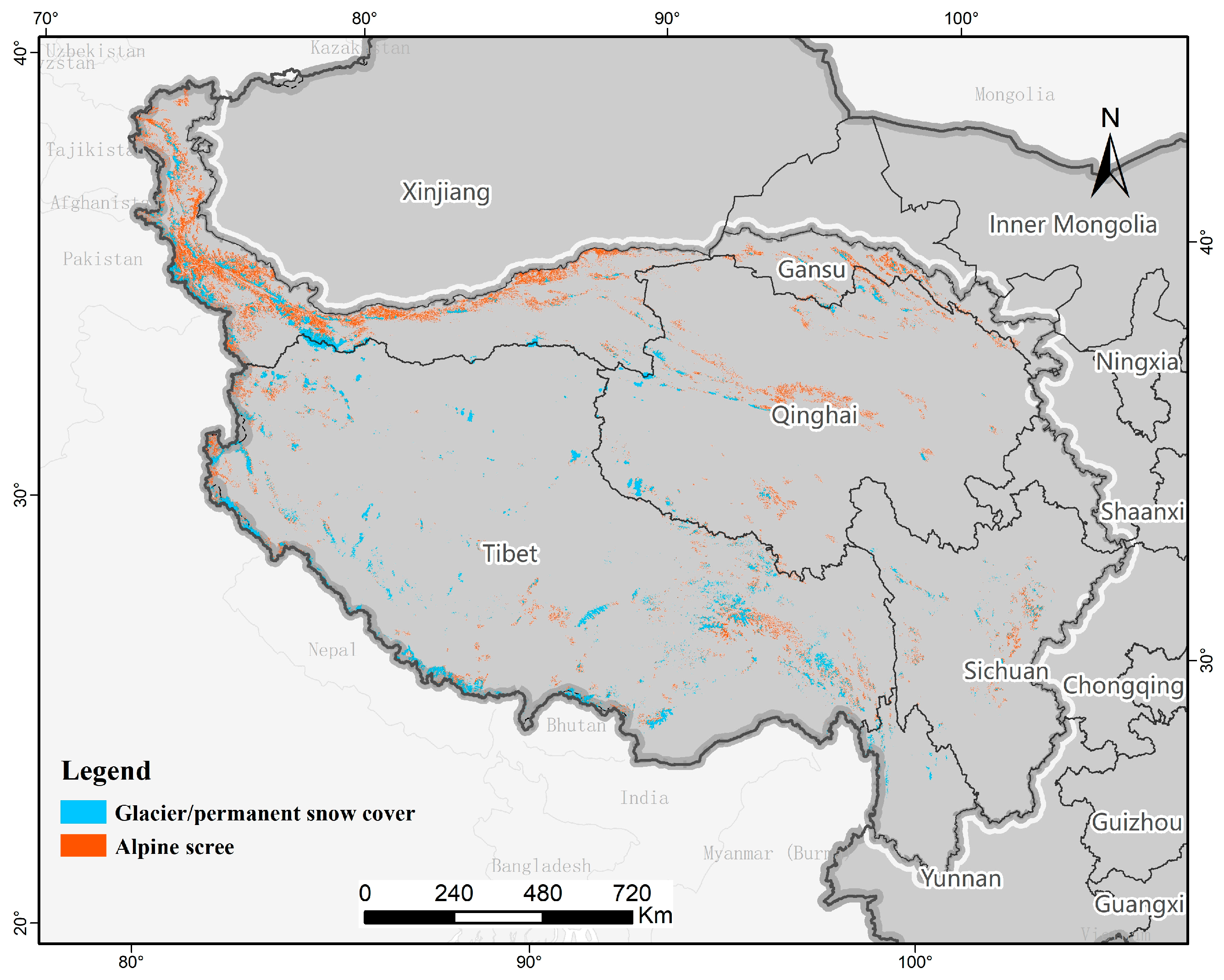
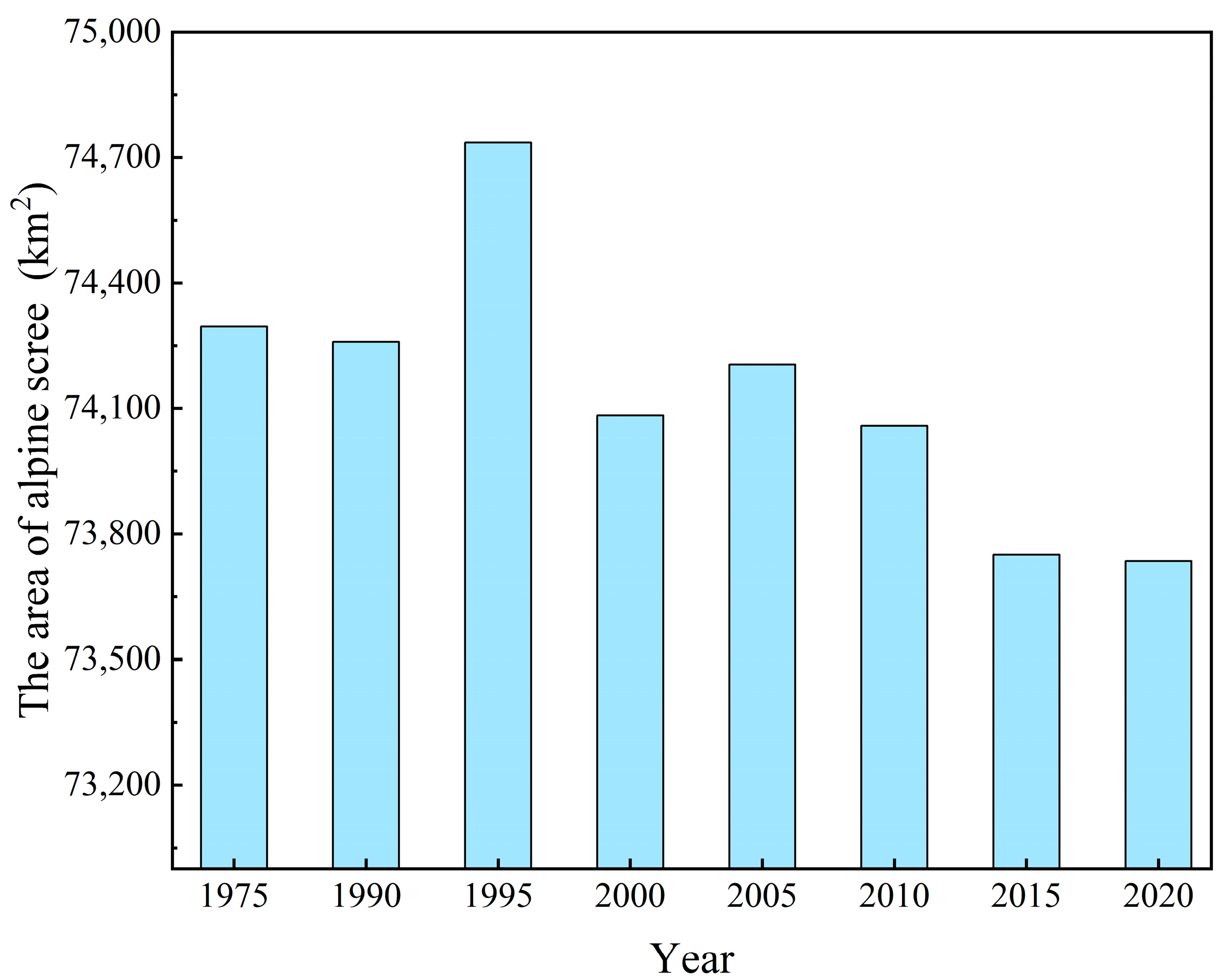

| Simulated Scree Points | Simulated Non-Scree Points | |
|---|---|---|
| Actual scree points | 39 | 2 |
| Actual non-scree points | 0 | 181 |
| Year/Ecosystem | 1995 | ||||||||
|---|---|---|---|---|---|---|---|---|---|
| Forest & Shrub | Grassland | Wetland | Urban | Glacier | Desert | Bare Land | Scree | ||
| 1975 | forest&shrub | / | / | / | / | / | / | / | 0.005 |
| grassland | / | / | / | / | / | / | / | 12.95 | |
| wetland | / | / | / | / | / | / | / | 0.59 | |
| glacier | 14.79 | 67.27 | 10.05 | 0 | / | 1079.20 | 1788.19 | 1040.91 | |
| desert | / | / | / | / | / | / | / | 312.49 | |
| Bare land | / | / | / | / | / | / | / | 582.53 | |
| scree | 0.83 | 3.50 | 0.65 | 0 | 302.28 | 482.87 | 719.77 | / | |
| Year/Ecosystem | 2020 | ||||||||
|---|---|---|---|---|---|---|---|---|---|
| Forest & Shrub | Grassland | Wetland | Urban | Glacier | Desert | Bare Land | Scree | ||
| 1995 | forest&shrub | / | / | / | / | / | / | / | 0.03 |
| grassland | / | / | / | / | / | / | / | 4.27 | |
| wetland | / | / | / | / | / | / | / | 0.78 | |
| glacier | 0.01 | 37.34 | 45.26 | 0.22 | / | 641.82 | 334.10 | 489.78 | |
| desert | / | / | / | / | / | / | / | 98.59 | |
| Bare land | / | / | / | / | / | / | / | 80.22 | |
| scree | 0.45 | 12.97 | 13.90 | 0.16 | 392.40 | 634.09 | 619.97 | / | |
| Variable | Coefficient | Standard Error | p | Odds Ratio | 95% CI |
|---|---|---|---|---|---|
| slope | 0.041 | 0.007 | 0.000 | 1.042 | 1.028–1.057 |
| DEM | −0.004 | 0.000 | 0.000 | 0.996 | 0.996–0.997 |
| Temperature change | 10.848 | 0.967 | 0.000 | 51,455.285 | 7732.274–342,414.988 |
| Precipitation change | 0.063 | 0.007 | 0.000 | 1.065 | 1.051–1.079 |
| AI change | 1.509 | 0.24 | 0.000 | 4.522 | 2.827–7.231 |
| constant | 15.601 | 1.111 | 0.000 | 5,962,047.931 |
| Variable | Coefficient | Standard Error | p | Odds Ratio | 95% CI |
|---|---|---|---|---|---|
| slope | −0.012 | 0.002 | 0.000 | 0.988 | 0.981–0.991 |
| DEM | −0.001 | 0.000 | 0.000 | 0.999 | 0.999–0.999 |
| Temperature change | −1.619 | 0.058 | 0.000 | 0.198 | 0.177–0.222 |
| Precipitation change | 0.003 | 0.000 | 0.000 | 1.003 | 1.003–1.004 |
| AI change | 0.296 | 0.012 | 0.000 | 1.344 | 1.312–1.376 |
| constant | 7.287 | 0.161 | 0.000 | 1461.294 |
Disclaimer/Publisher’s Note: The statements, opinions and data contained in all publications are solely those of the individual author(s) and contributor(s) and not of MDPI and/or the editor(s). MDPI and/or the editor(s) disclaim responsibility for any injury to people or property resulting from any ideas, methods, instructions or products referred to in the content. |
© 2025 by the authors. Licensee MDPI, Basel, Switzerland. This article is an open access article distributed under the terms and conditions of the Creative Commons Attribution (CC BY) license (https://creativecommons.org/licenses/by/4.0/).
Share and Cite
Zhang, G.; Wu, B.; Ying, L.; Zhao, Y.; Zhang, L.; Cheng, M.; Zhu, L.; Zhang, L.; Ouyang, Z. Climate Warming-Driven Expansion and Retreat of Alpine Scree in the Third Pole over the Past 45 Years. Remote Sens. 2025, 17, 2611. https://doi.org/10.3390/rs17152611
Zhang G, Wu B, Ying L, Zhao Y, Zhang L, Cheng M, Zhu L, Zhang L, Ouyang Z. Climate Warming-Driven Expansion and Retreat of Alpine Scree in the Third Pole over the Past 45 Years. Remote Sensing. 2025; 17(15):2611. https://doi.org/10.3390/rs17152611
Chicago/Turabian StyleZhang, Guanshi, Bingfang Wu, Lingxiao Ying, Yu Zhao, Li Zhang, Mengru Cheng, Liang Zhu, Lu Zhang, and Zhiyun Ouyang. 2025. "Climate Warming-Driven Expansion and Retreat of Alpine Scree in the Third Pole over the Past 45 Years" Remote Sensing 17, no. 15: 2611. https://doi.org/10.3390/rs17152611
APA StyleZhang, G., Wu, B., Ying, L., Zhao, Y., Zhang, L., Cheng, M., Zhu, L., Zhang, L., & Ouyang, Z. (2025). Climate Warming-Driven Expansion and Retreat of Alpine Scree in the Third Pole over the Past 45 Years. Remote Sensing, 17(15), 2611. https://doi.org/10.3390/rs17152611







